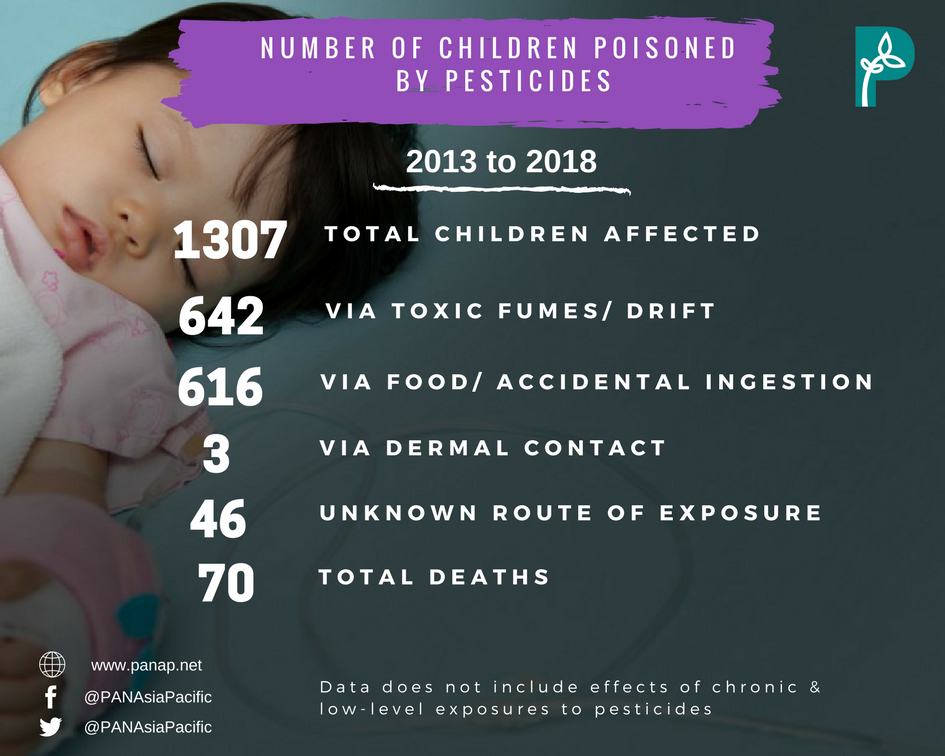In November 2017, ten-year-old Archana made tea for her grandparents, not knowing that she mistakenly mixed a packet of pesticides instead of tea. Within an hour, Archana and her grandparents died after being poisoned.
Over the last four months more than eight children have died from pesticide poisoning in India. Six of these children were fatally poisoned in Bihar district after accidentally consuming poison-laced tea just like Archana. Among the victims were seven-year-old Sanjeet Kumar and five-year-old Chandni Kumar from Bahdinpur village.
In the last six years, PANAP’s Protect Our Children (POC) Watch1 has documented 1,307 children poisoned by pesticides. Since 2017 alone, 539 children were poisoned by pesticides wherein 30 died. While the figures are not a comprehensive record of pesticide poisoning among children, the numbers are still shocking. Moreover, it also does not take into account those affected by the long-term and chronic effects of pesticides.


According to news reports, Sanjeet, Chandni and Achana all died from a pesticide called thimet which contains the highly hazardous pesticide phorate. Phorate is an organophosphates (OP) pesticide. In 2013, 27 children in Bihar lost their lives to another OP pesticide, morocrotophos.
Children’s Exposure to pesticides
OPs have been linked to breathing difficulties and neurological effects including lowered intelligence among children. Studies also show that even small doses of exposure to OPs may lead to birth defects, learning disorders and cancer. These risks are a serious infringement of children’s rights to safe and health food and a healthy environment.
Children are especially vulnerable to the impacts of pesticides. They face far bigger risk of exposure than adults and are more in danger of taking in pesticide residues in food and water. These hazardous pesticides are easily bought in stores and are kept in poor storage in many rural homes across Asia, thus further putting children at even bigger risk. Pesticides containing morocrotophos, phorate and chlorpyrifos easily find their way in environments were children play or help with their family’s work. Moreover, young children like Archana have easy access to these pesticides and are not able to distinguish pesticides from regular food items.
Farmers have also grown to depend on pesticides thinking they are medicine for their crops instead of considering these as poison. They often lack awareness of the hazards of these pesticides and are unable to wear any protective clothing while using these chemicals.
Often authorities tend to blame the farmers or end users instead of banning these highly hazardous pesticides in their respective countries. Phorate has been banned in over 37 countries including the EU. Monocropthos meanwhile is banned in 60 countries worldwide. Despite the ban and the numerous cases of poisoning, however, both pesticides have yet to be banned in India.
New discussion paper by UNICEF: Understanding the impacts of Pesticides on Children
Due to these growing concerns of how pesticides are impacting children, UNICEF released a new discussion paper to engage with various stakeholders to improve global pesticide regulations to support children’s rights.
Some key recommendations to stakeholders include:
- exploring agroecology as a method for more sustainable food production as well as to ban highly hazardous pesticides to address the growing issue that impact young children in rural areas;
- adapt the precautionary principle for pesticide registration;
- strengthening core business policies of pesticides companies ; and
- for states and governments to develop more robust national legislations.
Global and concentrated effort needed to phase out highly hazardous pesticides
On March 13-15, governments will gather for the second meeting of the intersessional process to discuss the strategic approach and the sound management of chemicals and waste beyond 2020 to discuss global chemicals management.
PANAP calls on the delegates of the strategic approach to international chemicals management (SAICM) intersessional process to consider the recommendations of UNICEF—among these, to develop a mechanism to be adopted by the ICCM5 for global governance of pesticides and phase out highly hazardous pesticides, with special attention to the rights and needs of children. We would also like to propose that governments consider a proposal on globally legally binding treaty on pesticide management for better global governance on pesticides.
Sanjeet, Chandi and Archana could have been protected along with many others. Governments should act before more children lose their lives to pesticides.
__________
1 The Protect Our Children (POC) Watch, is an initiative by PANAP and partners to closely monitor pesticide poisoning cases among children all over the world.








Discussion about this post